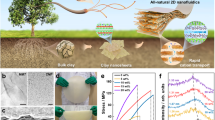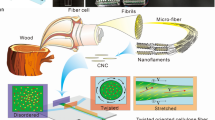Abstract
Osmotic energy between river water and seawater has attracted interest as a new source of sustainable energy. Nanofluidic membranes in a reverse electrodialysis configuration can capture energy from salinity gradients. However, current membrane materials suffer from high resistances, low stabilities, and low charge densities, which limit their further application. Here, we designed a high-performance nanofluidic membrane using carboxylic cellulose nanofibers functionalized with graphene oxide nanolamellas with cement-and-pebble microstructures and stable skeletons for enhanced ion transmembrane transport. By mixing artificial river water and seawater, the composite membrane achieved a high output power density up to 5.26 W m−2. Additionally, the membrane had an excellent acid resistance, which enabled long-term use with over 67 W m−2 of power density. The performance of this composite membrane benefited from the mechanically strong cellulose fibers and the bonding between nanofibers and nanolamellas. In this work, we highlight promising directions in industrial waste treatment using energy extracted from chemical potential gradients.

摘要
河水与海水之间存在的渗透能是一种新型、可持续的能源, 并引起了人们的广泛关注. 其中, 通过反向电渗析技术, 纳流体膜能够从盐度梯度中捕获这种能量. 然而, 目前的膜材料存在一些不足, 例如膜阻过高、稳定性差以及电荷密度低等, 这在很大程度上限制了它们的进一步应用. 在这项研究中, 我们设计了一种高性能的纳米复合膜, 该膜采用纤维素为主体并与氧化石墨烯复合, 具有类似“水泥-鹅卵石”结构的稳定骨架, 有利于增强离子跨膜传输. 在人工河水和海水环境中,复合膜的输出功率密度可达5.26 W m−2. 此外, 该膜在质子梯度条件下的功率密度超过67 W m−2, 且具有良好的耐酸性能, 可长期使用. 复合膜应用的多样性得益于机械强度高的纤维素与氧化石墨烯纳米结构间的结合作用. 在这项工作中, 我们展示了利用化学势梯度提取能量并且实现工业废水处理的前景.
Similar content being viewed by others
References
Logan BE, Elimelech M. Membrane-based processes for sustainable power generation using water. Nature, 2012, 488: 313–319
Jia Z, Wang B, Song S, et al. Blue energy: Current technologies for sustainable power generation from water salinity gradient. Renew Sustain Energy Rev, 2014, 31: 91–100
Xin W, Jiang L, Wen L. Two-dimensional nanofluidic membranes toward harvesting salinity gradient power. Acc Chem Res, 2021, 54: 4154–4165
Zhang Z, Wen L, Jiang L. Nanofluidics for osmotic energy conversion. Nat Rev Mater, 2021, 6: 622–639
Kong XY, Wen L, Jiang L. Towards practical osmotic energy capture by a layer-by-layer membrane. Trends Chem, 2020, 2: 180–182
Feng J, Graf M, Liu K, et al. Single-layer MoS2 nanopores as nanopower generators. Nature, 2016, 536: 197–200
Siria A, Poncharal P, Biance AL, et al. Giant osmotic energy conversion measured in a single transmembrane boron nitride nanotube. Nature, 2013, 494: 455–458
Guo Y, Huang H, Li Z, et al. Sulfonated sub-nanochannels in a robust MOF membrane: Harvesting salinity gradient power. ACS Appl Mater Interfaces, 2019, 11: 35496–35500
Chen S, Zhu C, Xian W, et al. Imparting ion selectivity to covalent organic framework membranes using de Novo assembly for blue energy harvesting. J Am Chem Soc, 2021, 143: 9415–9422
Liu YC, Yeh LH, Zheng MJ, et al. Highly selective and high-performance osmotic power generators in subnanochannel membranes enabled by metal-organic frameworks. Sci Adv, 2021, 7: eabe9924
Li C, Wen L, Sui X, et al. Large-scale, robust mushroom-shaped nanochannel array membrane for ultrahigh osmotic energy conversion. Sci Adv, 2021, 7: eabg2183
Bian G, Pan N, Luan Z, et al. Anti-swelling gradient polyelectrolyte hydrogel membranes as high-performance osmotic energy generators. Angew Chem Int Ed, 2021, 60: 20294–20300
Ding L, Xiao D, Lu Z, et al. Oppositely charged Ti3C2Tx, MXene membranes with 2D nanofluidic channels for osmotic energy harvesting. Angew Chem Int Ed, 2020, 59: 8720–8726
Wang C, Liu FF, Tan Z, et al. Fabrication of bio-inspired 2D MOFs/PAA hybrid membrane for asymmetric ion transport. Adv Funct Mater, 2020, 30: 1908804
Man Z, Safaei J, Zhang Z, et al. Serosa-mimetic nanoarchitecture membranes for highly efficient osmotic energy generation. J Am Chem Soc, 2021, 143: 16206–16216
Xie L, Zhou S, Liu J, et al. Sequential superassembly of nanofiber arrays to carbonaceous ordered mesoporous nanowires and their heterostructure membranes for osmotic energy conversion. J Am Chem Soc, 2021, 143: 6922–6932
Zhu X, Hao J, Bao B, et al. Unique ion rectification in hypersaline environment: A high-performance and sustainable power generator system. Sci Adv, 2018, 4: eaau1665
Xian W, Zhang P, Zhu C, et al. Bionic thermosensation inspired temperature gradient sensor based on covalent organic framework nanofluidic membrane with ultrahigh sensitivity. CCS Chem, 2021, 3: 2464–2472
Siria A, Bocquet ML, Bocquet L. New avenues for the large-scale harvesting of blue energy. Nat Rev Chem, 2017, 1: 0091
Chen C, Liu D, Yang G, et al. Bioinspired ultrastrong nanocomposite membranes for salinity gradient energy harvesting from organic solutions. Adv Energy Mater, 2020, 10: 1904098
Xin W, Xiao H, Kong XY, et al. Biomimetic nacre-like silk-crosslinked membranes for osmotic energy harvesting. ACS Nano, 2020, 14: 9701–9710
Chen J, Xin W, Chen W, et al. Biomimetic nanocomposite membranes with ultrahigh ion selectivity for osmotic power conversion. ACS Cent Sci, 2021, 7: 1486–1492
Chen C, Liu D, He L, et al. Bio-inspired nanocomposite membranes for osmotic energy harvesting. Joule, 2020, 4: 247–261
Abraham J, Vasu KS, Williams CD, et al. Tunable sieving of ions using graphene oxide membranes. Nat Nanotech, 2017, 12: 546–550
Cheng C, Jiang G, Simon GP, et al. Low-voltage electrostatic modulation of ion diffusion through layered graphene-based nanoporous membranes. Nat Nanotech, 2018, 13: 685–690
Chen L, Shi G, Shen J, et al. Ion sieving in graphene oxide membranes via cationic control of interlayer spacing. Nature, 2017, 550: 380–383
Xin W, Wen L. Two-dimensional materials for osmotic energy conversion. Chem J Chin Univ, 2021, 42: 445–455
Zhang Z, Yang S, Zhang P, et al. Mechanically strong MXene/Kevlar nanofiber composite membranes as high-performance nanofluidic osmotic power generators. Nat Commun, 2019, 10: 2920–2928
Xiong R, Kim HS, Zhang L, et al. Wrapping nanocellulose nets around graphene oxide sheets. Angew Chem Int Ed, 2018, 57: 8508–8513
Ries L, Petit E, Michel T, et al. Enhanced sieving from exfoliated MoS2 membranes via covalent functionalization. Nat Mater, 2019, 18: 1112–1117
Xin W, Zhang Z, Huang X, et al. High-performance silk-based hybrid membranes employed for osmotic energy conversion. Nat Commun, 2019, 10: 3876–3885
Gao J, Guo W, Feng D, et al. High-performance ionic diode membrane for salinity gradient power generation. J Am Chem Soc, 2014, 136: 12265–12272
Li R, Jiang J, Liu Q, et al. Hybrid nanochannel membrane based on polymer/MOF for high-performance salinity gradient power generation. Nano Energy, 2018, 53: 643–649
Zhu C, Liu P, Niu B, et al. Metallic two-dimensional MoS2 composites as high-performance osmotic energy conversion membranes. J Am Chem Soc, 2021, 143: 1932–1940
Xin W, Lin C, Fu L, et al. Nacre-like mechanically robust heterojunction for lithium-ion extraction. Matter, 2021, 4: 737–754
Zhang P, Chen S, Zhu C, et al. Covalent organic framework nanofluidic membrane as a platform for highly sensitive bionic thermosensation. Nat Commun, 2021, 12: 1844
Liu P, Zhou T, Teng Y, et al. Light-induced heat driving active ion transport based on 2D MXene nanofluids for enhancing osmotic energy conversion. CCS Chem, 2021, 3: 1325–1335
Chen K, Yao L, Su B. Bionic thermoelectric response with nanochannels. J Am Chem Soc, 2019, 141: 8608–8615
Hong S, Ming F, Shi Y, et al. Two-dimensional Ti3C2Tx MXene membranes as nanofluidic osmotic power generators. ACS Nano, 2019, 13: 8917–8925
Jones SF, Evans GM, Galvin KP. Bubble nucleation from gas cavities—A review. Adv Colloid Interface Sci, 1999, 80: 27–50
Macha M, Marion S, Nandigana VVR, et al. 2D materials as an emerging platform for nanopore-based power generation. Nat Rev Mater, 2019, 4: 588–605
Acknowledgements
This work was supported by the National Key R&D Program of China (2017YFA0206904 and 2017YFA0206900), and the National Natural Science Foundation of China (21625303, 22122207, 21905287, and 21988102).
Author information
Authors and Affiliations
Contributions
Wen L proposed the research direction and guided the project. Zhao Y and Xin W designed and performed the experiments. Wen L, Kong XY, Zhao Y, Xin W, Qian Y, Zhang Z, and Jiang L analyzed and discussed the experimental results and drafted the paper. Wu Y and Lin X joined the discussion of data and gave useful suggestions. All authors contributed to the writing of the paper.
Corresponding author
Additional information
Conflict of interest
The authors declare that they have no conflict of interest.
Supplementary information
Supporting data are available in the online version of the paper.
Yifei Zhao is currently a master’s degree candidate in physical chemistry at the Technical Institute of Physics and Chemistry (TIPC), Chinese Academy of Sciences (CAS) under the supervision of Prof. Liping Wen. Her current scientific interests are bioinspired nanochannel membranes and energy conversion.
Liping Wen is a professor at the TIPC, CAS. He received his PhD degree (2010) from the Institute of Chemistry CAS (ICCAS). He then worked as an associate professor at ICCAS. He obtained the the National Science Fund for Distinguished Young Scholars in China. His current scientific interests are the construction and application of bioinspired smart nanochannels and nanopores.
Rights and permissions
About this article
Cite this article
Zhao, Y., Xin, W., Qian, Y. et al. Cement-and-pebble nanofluidic membranes with stable acid resistance as osmotic energy generators. Sci. China Mater. 65, 2729–2736 (2022). https://doi.org/10.1007/s40843-022-2057-5
Received:
Accepted:
Published:
Issue Date:
DOI: https://doi.org/10.1007/s40843-022-2057-5




